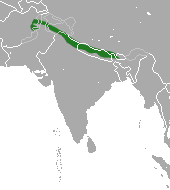Semnopithecus schistaceus
| Langur gris de Nepal | ||
|---|---|---|
 | ||
| Estado de conservación | ||
 Preocupación menor (UICN 3.1)[1] | ||
| Taxonomía | ||
| Reino: | Animalia | |
| Filo: | Chordata | |
| Clase: | Mammalia | |
| Orden: | Primates | |
| Familia: | Cercopithecidae | |
| Género: | Semnopithecus | |
| Especie: |
S. schistaceus Hodgson, 1840 | |
| Distribución | ||
 Distribución del langur gris de Nepal | ||
El langur gris de Nepal (Semnopithecus schistaceus) es una especie de primate catarrino de la familia Cercopithecidae que habita en los Himalayas y Nepal, sudoeste de China, norte de India, norte de Pakistán, Bután y posiblemente Afganistán.[2][1] Se lo encuentra en bosque en altitudes de 1500 a 4000 m s. n. m.[1] Su presencia más oriental en India es la Reserva Buxa Tiger al norte de Bengala Occidental, hasta el río Rydak.[3][4]
Es un animal tanto terrestre como arbóreo y su dieta se compone de hojas.[1] El espécimen más grande colectado pesó 26,5 kg, siendo el langur más grande conocido.[5]
Referencias[editar]
- ↑ a b c d Kumar, A., Yongzu, Z. & Molur, S. (2008). «Semnopithecus schistaceus». Lista Roja de especies amenazadas de la UICN 2024 (en inglés). ISSN 2307-8235. Consultado el 21 de agosto de 2011.
- ↑ Groves, Colin (2005). Wilson, D. E.; Reeder, D. M., eds. Mammal Species of the World (3ª edición). Baltimore: Johns Hopkins University Press. p. 174. ISBN 0-8018-8221-4.
- ↑ Choudhury, A.U. (2007). The eastern limit of distribution of the hanuman langur Semnopithecus entellus Dufresne. J. Bombay nat. Hist. Soc. 104 (2) : 199-200.
- ↑ Choudhury, A.U. (2009). Further changes in the eastern limit of distribution of the hanuman langur Semnopithecus entellus Dufresne. J. Bombay nat. Hist. Soc. 106(1): 90-91.
- ↑ Brandon-Jones, D. (2004). A taxonomic revision of the langurs and leaf monkeys ( Primates: Colobinae) of south Asia. Zoos Print J. 19:1552–1594
